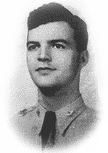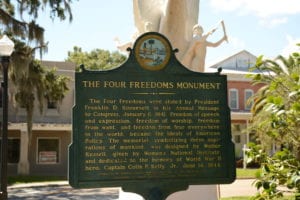History of Madison, FL
The City of Madison was founded on land secured from Madison C. Livingston, May 2nd 1838, and established as the county seat after its removal from San Pedro. An early political center, it was along the escape route of Confederate Secretary of War John C. Breckenridge in 1865. The town played a prominent role in the development of tobacco, livestock raising, and conservation in North Florida. Home of North Florida Community College, the area’s economy is based on agriculture and industry.
Cotton planters settled the town of Madison in 1838, though there were residents here before that. The county was established in 1827 and by 1850 the county population had grown to more than 5,000 people.
The world’s largest longstaple cotton gin was located in Madison before the boll weevil arrived in 1916, and wiped out the cotton industry. The “cotton years” memories are preserved in a small park near the Amtrak railroad station in the south side of town. In the park is a 16-foot drive wheel for a 500 horse power engine that once pulled 65 gins in what was said to be the world’s largest cotton processing plant.”
The oldest house in town, still occupied, was built in 1849 and a small wooden Episcopal church, built in 1843, is still in use.
In the center of Madison is the Wardlaw-Smith-Goza house, a stately mansion that dates from 1860 and served as a Confederate hospital during the War between the States.
Also, in the heart of downtown Madison is the Four Freedoms Park. The park is a beautifully landscaped city-block area containing a large gazebo, and the Four Freedoms monument. This famous monument honors Colin P. Kelley, a former Madison County resident who was recognized as the first U. S. hero of World War II and who was awarded the Distinguished Service Cross for his bravery and valor in combat.
Colin P. Kelly
On December 7, 1941 Pearl Harbor was attacked by the Japanese and war was declared. Within three days, a Madison County native became the first national hero of World War II — Captain Colin P. Kelly, Jr. On December 10th, Kelly’s B-17 Flying Fortress plane took off from Clark Field in the Philippines. During its bombing run, Kelly’s plane hit the Japanese cruiser Ashigara. On his return to Clark Field, Captain Kelly came under attack by Japanese Zero fighter planes. Captain Kelly managed to hold the plane in the air
until the surviving members of his crew were able to parachute to safety, however, Kelly was unable to escape and was killed. For his extraordinary heroism and selfless bravery, Captain Kelly was posthumously awarded the Distinguished Service Cross. The United States liberty ship SS Colin P. Kelly, Jr. was also named in his honor. The Four Freedoms Monument in Madison’s city park was commissioned by President Roosevelt and dedicated in Captain Kelly’s memory.
For information about Captain Colin P. Kelly, please view the following link:
Colin P. Kelly
About Four Freedoms
Founded in 1838, the City of Madison recently renovated its downtown area by restoring many of its historic buildings that show Antebellum and Victorian architecture at their finest. Carriage lights, brick sidewalks, and additional landscaping add to its charm.
Four Freedoms Park is located on the North side of Highway 90 directly across from the Madison Courthouse and across the street from the Chamber of Commerce. It is home to the Four Freedoms Monument. The monument commemorates the Four Freedoms identified by President Franklin D. Roosevelt in his address to Congress on January 6, 1941:
- Freedom of speech and expression,
- Freedom of worship,
- Freedom from want,
- Freedom from fear.
The monument was dedicated on June 14, 1944, in honor of Captain Colin P. Kelly, Jr., mentioned above. The monument was designed by Paul Russell.
Be sure to check out the “Madison Collection,” a photographic compilation from The Florida Memory Project.


